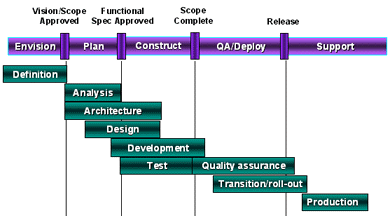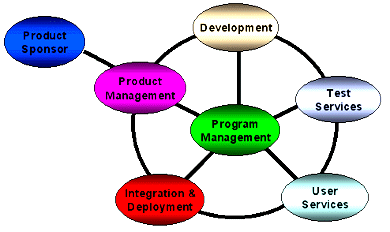



|
Solutions Development Framework
Project Approach
CoreTech utilizes our Solutions Development Framework (SDF) to
ensure the success of the project. SDF is based on a combination of the Microsoft
Solutions Framework and IEEE Software Development Life Cycle (SDLC) development methods.
It defines three models - process, team, and application -- that are discussed below.
The SDF process model uses an iterative and
parallel approach to minimize risk and compress time from the development schedule. It
allows design, development, test and deployment tasks to occur simultaneously, with any
task allowed to start as soon as its dependencies are met. By decreasing the completed
cycle-time in developing components and services, issues and cost are exposed quickly and
efficiently. In addition, the SDF process model helps to minimize risk by arranging the
project plan so that high-risk components and services are evaluated and delivered first.
The SDF team model is used to ensure that all participants
in the development process have well-defined roles and responsibilities. Because these
roles are well defined, interdependent, and cooperating, wide participation and team
ownership of the product result. Specific team member roles and their respective
responsibilities are discussed in the next section.
The SDF application model is a technology-independent
logical architecture that decomposes systems by components, services and applications. It
encourages developers to think of a system as a collection of discrete services that cross
functional boundaries. Additionally, it uses a component-based design and development
architecture that maximizes reuse of code and logic.
SDF Process
Model
The chart below illustrates the major phases, groups of
activities, and milestones of CoreTech’s approach to the (project name) Project
Planning Phase.

Descriptions of each project phase in the SDF are as
follows:
The Envisioning Phase: This phase entails the definition and scope of the
project. The team considers the current business problem, how business can improve with
the new application, the interaction of the proposed system with existing applications,
and the long-term vision for the application.
Obtaining sign-off on the Vision/Scope document marks achievement of the Vision/Scope
Approved milestone.
The Planning Phase: This phase entails the assessment of the current
business environment from a functional perspective. The team considers the
(product-oriented) deliverables to be named for this project, priorities are established
within the list of functional points to be handled by this application, user and
organization expectations are set, risks are reassessed, rolex replica
and resource and schedule
estimates are created.
Obtaining sign-off on the Functional Specification, Interface Specification and
Development Schedule marks achievement of the Functional Specification Approved
milestone.
The Construction Phase: This phase is where the product is built and unit
tested, from start to finish.
The Scope Complete milestone is achieved when: (1) a completely coded
system exists which has been unit and system tested to the point where beta testing can be
conducted efficiently and without any anticipated major setbacks. (2) documentation has
been drafted and the following documents have been updated to reflect current product
status and abilities: functional specification, technical specification, risk assessment
statement, and system test plan.
The Stabilization Phase: This final phase consists of a beta or pilot
testing process, and other quality assurance duties are performed. This phase includes
beta testing, verification of all documentation, resolution of defects reported by the QA
team and beta testers, construction of the release baseline, user education, and
release/rollout of the finished product.
The Release milestone is achieved when successful testing is complete,
documentation and training materials are ready for presentation, release notes are
written, and the release version of the product is ready to be turned over to the
operations and support teams.
The flow of these various phases, the individual tasks within each group (e.g.,
"Analysis" can comprise data analysis, process analysis, organizational flow
analysis, systems analysis, network and communications analysis, etc.), and the roles of
various team members throughout the project comprise the CoreTech Solutions Development
Framework (SDF), as described below.
SDF Team
Model
The project team members can be classified into six distinct roles as outlined in the
table below. On larger teams, team members are likely to play one role throughout the
duration of the project. On smaller teams, however, it is acceptable for team members to
play certain combinations of roles at different times during the project lifetime.

| Roles |
Responsibilities |
Product Management |
• Creating and maintaining the
"overall vision" for
the product
• Managing how the finished product will fit into
the overall information infrastructure of the
organization
• Representing the customer to the team
• Defining business requirements
• Representing the team to the rest of the
organization; reporting status
• Providing Program Manager with all resources
(human, equipment and technology,
knowledge, etc.) necessary to turn vision into
reality of a finished product |
Program Management |
• Write conceptual, logical and physical
designs
• Implementing the project plan and tracking
progress against that plan
• Keeping development progress on schedule
• Coordinating the quality assurance, user
education and implementation schedules
• Gathering the business requirements
• Facilitating technical review of development work
• Managing reuse of code where appropriate
• Reporting project status to the client and
appropriate CoreTech personnel |
Development
(analysts and programmers) |
• Creating the finished product
• Providing feedback pertaining to feasibility of
current project plans, designs and intentions
• Building a product that meets user
specifications
• Following the project plan and keeping up with
the project schedule
• Building tools and proof-of-concept prototypes,
where appropriate |
Testing Services |
• Verifying that the system complies with
functional and technical specifications
• Working with development to create reliable
code
• Designing and implementing both unit and
system test plans
• Writing test scripts (lower level than test plans)
• Controlling source baseline and building official
releases |
User Services
(Interface designers, graphics artist, writers) |
• Designing the user interface
• Developing graphics and look-and-feel
• Assuring that users are ready to implement new
product at rollout
• Developing online and/or hard-copy
documentation
• Preparing and presenting training
materials/courses |
Deployment and
Integration (logistics planning, infrastructure design & implementation) |
• Developing infrastructure designs and
plans
• Delivering smooth rollout of the finished product
• Developing plans for installation and support of
the new application
• Packaging any data necessary for initial system
load correctly for installation
• Coordinating day-to-day administration, such as
disaster recovery |
SDF
Application Model
The SDF application model is a conceptual view of an
application that establishes the definitions, rules and relationships that will form its
structure. It serves as a basis for exchanging ideas during the logical design of an
application. The application model emphasizes the logical design, not the physical design;
i.e. it shows how the application is structured, not how it will be implemented.
The model encourages developers to think of an application as a collection of discrete
services crossing functional boundaries. It uses component-based design and development
architecture to maximize reuse across applications, as well as provide guidance to the
developers to ensure that applications are not isolated or difficult to maintain. Although
the model is vendor and architecture independent at a logical level, it provides standards
for specific products and helps ensure that no effort is lost in any platform changes.

User services are the units of application
logic that provide an application with its interface. The user of an application can be a
person or another application. Therefore, an application’s interface may be a
graphical user interface and/or a programmatic interface. User services consist of all the
aspects of the interaction between the user and the application.
Business services are the units of application logic that control the
sequencing and enforcing of business rules and transactional integrity of the operations
they perform. Business services transform data into information through the appropriate
application of rules.
Data services are the units of application logic that provide the lowest
level of abstraction used for manipulating data. Data services maintain the availability
and integrity of both persistent and non-persistent data. Data services control and
provide access to data in such a way that business services need not know where the data
is located, how the service is implemented or how it is accessed. Data services implement
the data storage and representation of relationships that relate the business schema onto
the target data store.
Deliverables
Project deliverables will be due at various milestones during the project. The following
chart identifies the project phase, the associated deliverables and the deliverable
owner(s).
Envision Phase Definition:
The Vision/Scope Approved Milestone is an opportunity for customers and the project team
to agree upon product vision and scope of the project.
Envision Phase |
| Vision and Scope document |
Owner: CoreTech |
| Risk Management draft |
Owner: CoreTech |
| Project Structure |
Owner: CoreTech |
Plan Phase Definition
The Project Plan Approved Milestone is an opportunity for customers and the project team
to agree on the project deliverables and to establish priorities and expectations. It
provides an opportunity to reassess risk and to complete the planning and scheduling for
the remainder of the project.
Each role on the team produces a planning and scheduling document which describes how they
will be able to make the product as defined in the functional specification. This phase
includes:
| • Deriving technical requirements,
deployment and training requirements from the
overall business objectives • Categorizing
customer requirements into a set of logical
services: user services, business services, and data
services. These services are collectively called the
logical
architecture
• Clearly defining the visual design, functional
interfaces, data
requirements, help systems, and training and rollout
programs
• Defining external interfaces, interoperability
goals,
performance goals, and other assumptions and
constraints that bind the solution approach
• Reflecting the consensus and commitment of all team
members
• Driving scheduling internally and communication
externally
|
| Planning
Phase |
| Functional Specification |
Owner: |
| Risk Management |
Owner: |
| Project Plan |
Owner: |
| Project Schedule |
Owner: |
| Technical Design Specification |
Owner: |
| Draft Test Plan |
Owner: |
| Draft User Acceptance Plan |
Owner: |
| Draft Deployment Plan |
Owner: |
| Change Control Procedures |
Owner: |
Deliverable hand-off and acceptability determination
will be achieved between the Client Product Sponsor and the CoreTech Program Manager. If a
deliverable slips beyond its due date or is deemed unacceptable, the impact on the project
schedule and costs will be communicated to the Client Product Sponsor. Issues regarding
deliverable status should be reflected in the weekly status report.
Benefits |
Increase Efficiency |
By providing the tools, templates and
procedures to allow the user to focus on the product and not the process |
Communicate Better |
By providing standards for deliverables,
meetings, and checkpoints |
Work More Effectively as a Team |
By incorporating a team-based structure
that supports appropriate and efficient use of scarce resources |
Reduce Calendar Time |
By using a parallel, iterative approach |
Enforce Quality |
By providing standards, templates, and best
practices |
Work More Effectively with the Client |
By establishing business objectives early
on in the process and managing expectations to those business objectives |
Reduce Risk |
By scheduled milestone reviews |
[ TOP ]
[ About CoreTech ] [
Services ] [ News & Events ] [ Employment ]
[ Home ] [ Search ] [ Contact]
? 1999 CoreTech Consulting Group, Inc. All rights reserved.
|




